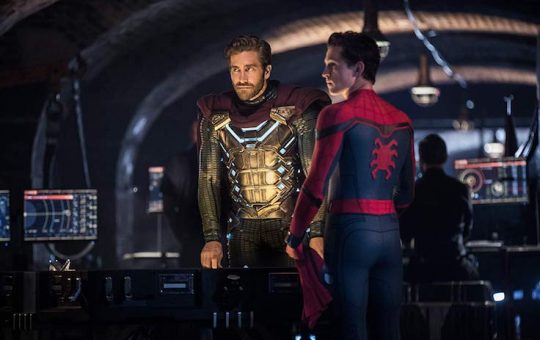So, here’s a thing about Spider-Man/Peter Parker as incarnated by Tom Holland: He’s short.
Spidey’s dwarfed by Nick Fury (Samuel L. Jackson), the sneakiest, scariest person on the planet. He’s swallowed up by Happy Hogan (Jon Favreau), the Stark Industries majordomo making the moves on Aunt May (Marisa Tomei), who is twice Spidey’s width. Spidey may be the first superhero whose potential significant other towers over him: his would-be girlfriend, MJ (Zendaya), has a few inches on him. He’s just a little guy, a runt, an underdog whose powers are greater than the responsibility he wants to shoulder.
In short (haha): He’s perfect as the friendly, neighborhood Spider-Man, the least-likely Avenger.
Now, Holland’s not actually THAT diminutive. He’s only a hair shorter than Robert Downey Jr., if Google is to be trusted. But Downey’s outsize personality imbued Iron Man and Tony Stark with a larger-than-life persona that led to it eclipsing much of the rest of the Marvel Cinematic Universe. One of the reasons that Far From Home’s predecessor, Spider-Man: Homecoming, worked as well as it did was that it was, in many ways, a story about Tony Stark as much as it was a story about Peter Parker. This wasn’t an Uncle Ben-driven rehash of the radioactive spider’s fateful bite. Rather, it was about Stark’s effort to find an heir apparent, someone with brains and personality who could be trusted to do the whole superhero thing right.
The ghost of Tony Stark looms over Far From Home. Literally, in a way: murals of Stark in his Iron Man getup dot New York City’s skyline and Venice’s waterways with equal regularity. Which is only fitting: He saved not only Earth but all of creation, concocting the plan to resurrect half of the universe’s population following Thanos’s finger snap and then sacrificing himself to wipe out the purple-skinned Titan’s hordes at the climax of Avengers: Endgame. The creators of Far From Home had the unenviable task of trying to pick up the pieces, and do an admirable job of getting it to all make sense.
Helping matters is the fact that they have an inherently ludicrous background to play with: high school. Snapping people away for five years and then bringing them back is bizarre in most any circumstance, but in high school, that land of puberty and puppy love and locker-stuffing bullies, forcing kids who have been blinked out of existence for half a decade to figure out how to go on with exams is just another indignity.
While touring Europe with his friends, Parker is roped into helping Nick Fury and Quentin Beck (Jake Gyllenhaal), codenamed Mysterio following his public debut in Italy, defeat a quartet of superpowered villains wreaking havoc across the continent. The Elementals—living embodiments of water, earth, fire, and wind—destroyed the Earth on Beck’s partition of the Multiverse, and he has come to Parker’s Earth to ensure we do not suffer the same fate.
Gyllenhaal is clearly having a fine time with the role of Beck, gliding seamlessly between inspirational hero and infuriating huckster as the movie progresses and more of his plan is revealed. Special credit must be given to the effects team, which brings to life Mysterio’s trippy, perception-altering powers in a way once thought unimaginable for a live-action film. That being said, Far From Home doesn’t quite rise to the level of Homecoming if only because Gyllenhaal’s Mysterio doesn’t have quite the same pathos or reasonableness of Michael Keaton’s Vulture.
Still: There’s action and adventure and special effects with a bit of mystery and a dash of subterfuge thrown in for good measure. That is to say, it’s an effective summer blockbuster. A good time is had by all, and the Marvel Cinematic Universe begins its move into a post-Robert Downey Jr. existence by giving his (tiny) heir apparent room to grieve—and grow.
###
And now, some personal news: This will be my final movie review for the Washington Free Beacon. After seven-plus years as an editor—first managing, then executive, possibly a title in between that I’ve forgotten about—and seven almost exactly as its film critic, I am leaving the Beacon to join CINESTATE, a movie studio based in Dallas, to help them build a new digital brand and publication that will be dedicated to … well, movies. I couldn’t be more excited for this amazing new opportunity.
The brainchild of Dallas Sonnier, CINESTATE is probably best known for producing S. Craig Zahler’s excellent trio of films: Bone Tomahawk, Brawl in Cell Block 99, and Dragged Across Concrete. They also released The Standoff at Sparrow Creek, which I quite liked, and via the resurrected FANGORIA brand, a handful of horror films. Given what Dallas and FANGORIA EIC Phil Nobile have done with that storied mag over the last year or so, I’m honored to join the CINESTATE team and start a brand-new venture.
I am of course, sad to be leaving the Beacon: having been here since day one, this new opportunity is bittersweet. But I’ll still be doing the Sub-Beacon podcast with Vic Matus and Jonathan V. Last, so you haven’t seen the last of me on these digital pages. (I’ll also continue writing my WashingtonPost.com column and will still appear on the Hugh Hewitt show every Friday morning during the 6:50 A.M. segment.) I shall forever be grateful to Matthew Continetti for offering me the chance to join the Beacon on my wedding day and to Michael Goldfarb for not only bringing this outlet into existence but also introducing me to Bone Tomahawk.
That being said, I’m thrilled to be joining CINESTATE and can’t wait to share what I and the rest of the team are up to. Twitter is probably the best place for news on this front: follow me at @SonnyBunch and the studio at @Cinestate.
